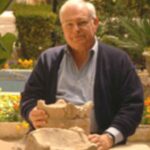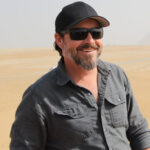History
Dedicated Since 1900 to the Study of the Ancient Near East
The history of the Albright is the history of American archaeology in the Near East. Our fascinating history is replete with turn-of-the-century adventures on horseback, wars at our front door, an assassination, monks buried in the backyard, and countless contributions and innovations. The Dead Sea Scrolls were first examined and photographed in our library basement, and Flinders Petrie’s head may have had a stopover in our offices on the way to London.
Overnight, boundaries and borders, even our host country, have changed several times. As Philip J. King recounts in his American Archaeology in the Mideast: A History of the American Schools of Oriental Research, the changes, here describing the aftermath of the Six-Day War, could be head-snapping:
The new international boundaries that resulted from the war restricted the scope of the School’s field trips. Before 1967 it had been easy to travel to most of the Arab countries from East Jerusalem; now that was no longer possible. However, as compensation, Israel (which had been off-limits for field trips from 1948 to 1967) now welcomed visits from residents of the Jerusalem School. It was a strange reversal of the previous situation, but such vicissitudes are routine in the Mideast. (184)

American Colony (Jerusalem). Photo Dept., photographer. Large stone blocks of ancient city wall of Jer. [i.e., Jerusalem] (Agrippa's wall). Near American School of Oriental Research in "Musrara" Quarter. 1934-1939. Matson Collection, Library of Congress, Washington, DC.
American Colony (Jerusalem). Photo Dept., photographer. Large stone blocks of ancient city wall of Jer. [i.e., Jerusalem] (Agrippa's wall). Near American School of Oriental Research in "Musrara" Quarter. 1934-1939. Matson Collection, Library of Congress, Washington, DC.

The American School of Oriental Research – renamed the Albright Institute in 1970 – is founded in Jerusalem. Its first director is Charles C. Torrey, Professor of Old Testament at Yale University and the first Fellow is Martin A. Meyer, a recent graduate of the Hebrew Union College.
Serving as director of the institution that would one day bear his name, W. F. Albright, the father of Biblical Archaeology, presides over the Golden Age of Near Eastern Archaeology and Biblical Studies. His excavations at Tell Beit Mirsim (1926-1932) produce the first definitive ceramic chronology that becomes the basis of the discipline of Bronze and Iron Age archaeology in the Levant.
Director Nelson Glueck surveys the Transjordan. identifying more than 1,000 sites and producing, in effect, a primary archaeological textbook of the region, which is still used today. Glueck’s work is rated as one of the two most important individual contributions to the field of Palestinian archaeology in his generation after the work of Albright.
A revolution in the study of the Hebrew Bible and Second Temple Judaism is sparked by the discovery of the Dead Sea Scrolls in caves near Khirbet Qumran. Acting Director John Trevor took the first photographs of the scrolls in the basement of the Jerusalem School and sent them to W. F. Albright in the United States. Albright responded, declaring the scrolls to be “the greatest manuscript discovery of modern times.”
Director Paul Lapp’s pioneering volume on the Late Hellenistic and Roman periods makes a major contribution to the study of Palestinian pottery. His groundbreaking excavations at Tell el Fûl, Bab edh-Dhra, and Tell Ta`anach set a new standard for archaeological fieldwork.
The Jerusalem School officially becomes the William Foxwell Albright Institute of Archaeological Research.
Director William G. Dever – well-known for his extensive research in Bronze and Iron Age archaeology – heads the excavations at Tell Gezer, where he discovers the Solomonic Gate. His innovations in field work at Gezer include the introduction of a multi-discipline approach to excavations. Gezer was also one of the first projects to introduce the large-scale use of volunteers. His work at Gezer is largely responsible for training the next generation of American archaeologists working in Israel and Jordan.

Dorot Director Seymour (Sy) Gitin, together with Professor Trude Dothan of the Hebrew University conducts the first joint American-Israeli excavation at the site of Tel Miqne-Ekron in which one of the three most important finds of the 20th century is discovered – The Ekron Royal Dedicatory Inscription. His research demonstrates the vitality of Philistine material culture, which reaches its zenith of development in the 7th century B.C.E. Under Gitin’s leadership, the Institute develops one of the largest doctoral and post-doctoral research centers in ancient Near Eastern Studies.

Matthew J. Adams serves as Dorot Director of the Albright Institute.

Katharina Schmidt serves as Dorot Directorship of the Albright Institute.

James Fraser serves as Dorot Director at the Albright Institute.
For more information about the history and development of the Albright, see Philip J. King’s American Archaeology in the Mideast: A History of the American Schools of Oriental Research, Winona Lake, IN: Eisenbrauns, 1983; and An ASOR Mosaic: A Centennial History of the American Schools of Oriental Research, 1900-2000, ed. Joe D. Seger, Boston: American Schools of Oriental Research, 2001 (specifically pp.125-238, the chapter on the Albright, and pp.80, 89-93, on the Albright Centennial).






